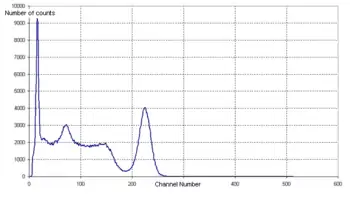Multichannel analyzer
A multichannel analyzer (MCA) is an instrument used in laboratory and field applications, so to analyze an input signal consisting of pulses.[1] MCAs are used extensively in digitizing various spectroscopy experiments, especially those related to nuclear physics, including various types of spectroscopy (alpha-, beta-, and gamma spectroscopy). MCAs are typically interfaced with via USB, RS-232 or Ethernet, but can use PCI also.

Operation

A multichannel analyzer uses a fast ADC to record incoming pulses and stores information about pulses in one of two ways:[1]
Pulse-height analysis
In pulse-height analysis (PHA) mode, the pulses are counted based on their amplitude. The number of different amplitudes that are counted depends on the number of channels of the MCA, but is normally in the range of a few thousand. In this way a histogram of frequency against pulse amplitude (or "height") can be produced and either sent to a computer, shown on a screen or (in older models) directly printed. This mode can be used to analyze energy distribution of various nuclear processes, including nuclear decay:[2] this is the process used in alpha-, beta-, and gamma spectroscopy.
Multichannel scaling mode
In multichannel scaling (MCS) mode, the pulses are counted in a given time period, and in the channel the pulses are input as changes over time (rather than with amplitude as in PHA mode). The trigger for changing channel can be used for changing other parameters of an experiment, allowing an MCA to be used as an X–Y recorder. This mode can be used in conjunction with a Geiger counter to see a change in radioactivity over time.
See also
References
- "THE MULTICHANNEL ANALYZER" (PDF). Western University. Retrieved 27 March 2016.
- "Gamma Spectroscopy with a Scintillation Detector and Multichannel Analyzer" (PDF). American University in Bulgaria. Retrieved 27 March 2016.